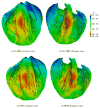Rabbit-specific ventricular model of cardiac electrophysiological function including specialized conduction system
- PMID: 21672547
- PMCID: PMC3190654
- DOI: 10.1016/j.pbiomolbio.2011.05.002
Rabbit-specific ventricular model of cardiac electrophysiological function including specialized conduction system
Abstract
The function of the ventricular specialized conduction system in the heart is to ensure the coordinated electrical activation of the ventricles. It is therefore critical to the overall function of the heart, and has also been implicated as an important player in various diseases, including lethal ventricular arrhythmias such as ventricular fibrillation and drug-induced torsades de pointes. However, current ventricular models of electrophysiology usually ignore, or include highly simplified representations of the specialized conduction system. Here, we describe the development of an image-based, species-consistent, anatomically-detailed model of rabbit ventricular electrophysiology that incorporates a detailed description of the free-running part of the specialized conduction system. Techniques used for the construction of the geometrical model of the specialized conduction system from a magnetic resonance dataset and integration of the system model into a ventricular anatomical model, developed from the same dataset, are described. Computer simulations of rabbit ventricular electrophysiology are conducted using the novel anatomical model and rabbit-specific membrane kinetics to investigate the importance of the components and properties of the conduction system in determining ventricular function under physiological conditions. Simulation results are compared to panoramic optical mapping experiments for model validation and results interpretation. Full access is provided to the anatomical models developed in this study.
Copyright © 2011 Elsevier Ltd. All rights reserved.
Figures






References
-
- Ansari A, Ho S, Anderson RH. Distribution of the Purkinje fibres in the sheep heart. The Anatomical Record. 1999;254:92–97. - PubMed
-
- Azzouzi A, Coudiere Y, Turpault R. A mathematical model of the ventricular conduction system. ICNAAM 2010 AIP Conf Proc. 2010;1281:403–406.
-
- Berenfeld O, Abboud S. Simulation of cardiac activity and the ecg using a heart model with a reaction-diffusion action potential. Med Eng Phys. 1996;18:615–625. - PubMed
-
- Berenfeld O, Jalife J. Purkinje-muscle reentry as a mechanism of polymorphic ventricular arrhythmias in a 3-dimensional model of the ventricles. Circ Res. 1998;82:1063–1077. - PubMed
Publication types
MeSH terms
Grants and funding
LinkOut - more resources
Full Text Sources

